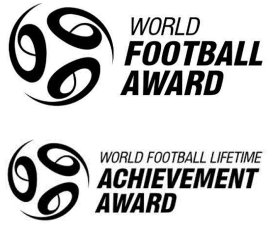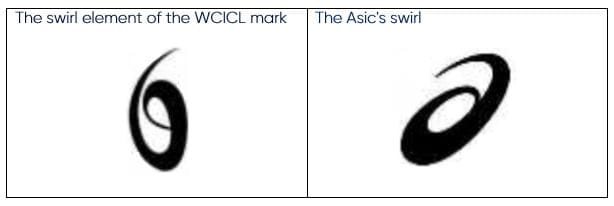- Home
- News & Insights
- Insights
- The Asics swirl
- Auf dieser Seite
31. Mai 2023
Brands Update - May 2023 – 3 von 9 Insights
The Asics swirl: rare finding of indirect confusion
- In-depth analysis
The UK Intellectual Property Office (UKIPO) has found indirect confusion between the well-known Asics swirl and a third-party application containing three similar swirls arranged in the shape of a football together with the words WORLD FOOTBALL AWARD/ WORLD FOOTBALL LIFETIME ACHIEVEMENT AWARD. The decision contrasts with that of the EU Intellectual Property Office (EUIPO) in the same case, which found that the marks in question were not similar.
What has happened?
- The case concerns an opposition by the owner of the Acics swirl to the registration of an allegedly similar swirl (repeated three times to produce a shape evocative of a football) together with the words WORLD FOOTBALL AWARD or WORLD FOOTBALL LIFETIME ACIEVEMENT AWARD.
- In contrast to previous decisions of the EUIPO, the UKIPO held the marks similar (albeit only to a low degree) and found a likelihood of indirect confusion for some of the goods/services applied for. Indirect confusion occurs where the average consumer does not mistake the marks for one another but nonetheless considers that they come from the same or economically linked undertakings (see our article here).
- A key factor in the finding of indirect confusion was the enhanced distinctive character and reputation of the Asics swirl, with the UKIPO holding that, where this is the case, brand extensions and sub-branding arrangements are often logical.
- Indirect confusion is a relatively rare – but important – finding. Brand owners should give careful thought to the possibility of indirect confusion when clearing new brands for use and registration. The risk will vary depending on a number of factors including the nature of the market in question, the propensity for brand extensions in that market, the distinctiveness of any shared brand elements, the nature of any differences between the marks and the degree of attention of the average consumer.
- The opposition based on unfair advantage and passing off was also successful. On passing off, the UKIPO considered that the average consumer would mistakenly believe that Asics approved or endorsed the goods or services bearing the images of the World Champion Imprint Club Limited (WCICL) mark.
- It is relatively rare for the UKIPO and EUIPO to come to different conclusions on largely the same facts. The difference of opinion here cannot be explained by the enhanced distinctiveness and reputation of the Asics swirl since that is irrelevant for determining the degree of similarity between marks. However, it is possible that it had an indirect impact on the decision-maker's perception of the degree of similarity between the marks.
Want to know more?
The Background
WCICL filed applications for two marks in the UK, WORLD FOOTBALL AWARD (and logo) and WORLD FOOTBALL LIFETIME ACHIEVEMENT AWARD (and logo) in classes 3, 9, 14, 16, 18, 21, 25, 28, 35, 38 and 41.

Kabushiki Kaisha Asics trading as Asics Corporation opposed both applications, arguing that the marks applied for by WCICL were confusingly similar to - and take unfair advantage of the reputation of - its earlier UK swirl logo registration in classes 18, 25 and 28. It also opposed the applications on the basis of its prior passing off rights in the swirl logo dating from 1993.

Asics's registration
The UKIPO judgement
Similarity of goods and services
The UKIPO conducted a thorough review of the specifications of the marks and limited the goods on which Asics could base its opposition, as it was only able to prove use for certain terms. For example, Asics was unable to rely on broad terms such as clothing, as its use was only in relation to a subcategory of clothing - sportswear.
The UKIPO found that some of the goods applied for by WCICL, such as rucksacks, footwear, hats and sports clothing were identical to those registered by Asics, and some, such as shirts, pullovers, bags designed for sports equipment, were similar to a high degree. Other goods, such as footballs and barbells were similar to a medium degree, and several terms, such as umbrellas, business administration and the entirety of the specification in class 41 were dissimilar.
Comparison of the marks

Although Asics argued that the words WORLD FOOTBALL AWARD and WORLD FOOTBALL LIFETIME ACHIEVEMENT AWARD are descriptive, the UKIPO found that the device and the word elements contribute equally to the overall impression of the WCICL's marks, as they reinforce each other to convey the same concept (the swirls being arranged to denote a football).
The UKIPO held that the marks were visually similar to a fairly high degree (if considering the swirls alone) but only to a medium degree (when factoring in that the WCICL's swirls are arranged in the shape of a football) and then to a low degree (when factoring in that the WCICL mark contains additional word elements).
It was not possible to carry out an aural comparison between the marks.
Asics argued that the presence of the swirls in both marks creates a conceptual similarity, with which the UKIPO agreed. Even considering the football arrangement, the highly similar graphic representation of the swirls means that the competing marks both evoke the concept of a distinctively similar swirl, and average consumers will perceive these similarities at a more specific level.
Enhanced distinctive character and reputation of the Asics swirl
The UKIPO considered that the Asics swirl was inherently distinctive to a medium-high level. Asics provided evidence of the use and reputation of the mark, which was accepted by the UKIPO, it finding that the Asics mark had a very high degree of distinctiveness overall for the goods in classes 18, 25 and 28.
Likelihood of confusion
The UKIPO held that there was no likelihood of direct confusion given the differences between the marks. However, it found a likelihood of indirect confusion. Indirect confusion occurs where the average consumer does not mistake the marks for one another but nonetheless considers that they come from the same or economically linked undertakings (which could include where there is a cobranding or sub-branding arrangement).
Given the similarity between the Asics swirl and the WCICL swirl and the enhanced distinctive character of the former, the average consumer with imperfect recollection would view the three WCICL swirls as Asics swirls and overlook the differences. This is particularly so as, where there is enhanced distinctive character and reputation, brand extensions and sub-branding arrangements are logical. The opposition based on likelihood of confusion was successful for the goods and services which were previously found to be similar.
Indirect confusion is a relatively rare – but important – finding. Brand owners should give careful thought to the possibility of indirect confusion when clearing new brands for use and registration. The risk will vary depending on a number of factors including the nature of the market in question, the propensity for brand extensions in that market, the distinctiveness of any shared brand elements, the nature of any differences between the marks and the degree of attention of the average consumer.
Unfair advantage
The UKIPO considered the following factors when assessing whether Asics has a reputation for its swirl:
- Length of use – the Asics swirl was launched in the UK in 1993 and has been in use continuously since that date.
- Intensity of use (in terms of turnover) – Asics was able to show a significant UK turnover in the latest five-year period.
- Marketing efforts – the Asics swirl has been promoted through global advertising campaigns.
- Degree of brand recognition – Asics submitted a YouGov survey and evidence that it is consistently ranked as a top Japanese brand.
The UKIPO was satisfied that the Asics marks will be brought to mind by the WCICL mark, even when used for dissimilar goods or services. The UKIPO upheld the claim for unfair advantage and the opposition was successful for all goods and services objected to by Asics.
Passing Off
The UKIPO found that a substantial number of consumers would likely be deceived into believing that Asics officially approved or endorsed the goods or services bearing the images of the WCICL mark. The partial opposition on the basis of passing off was entirely successful.
The UK and EU
In the same action, the EUIPO held that the marks were not similar and that there could therefore be no finding of a likelihood of confusion or unfair advantage. No amount of enhanced distinctiveness can cause marks to be deemed similar when they are not. This is a relatively rare example of when the UKIPO and EUIPO disagree on substantially similar facts.
This article was co-authored by Hope Riseley.
In dieser Serie
NFTs, virtual goods, and services provided in the metaverse: UK IP Office issues guidance on classification
31. Mai 2023
A second bite of the cherry? Introducing new evidence in appeal proceedings at the EUIPO
31. Mai 2023
First ECJ decision on visibility and intended use in relation to complex products
31. Mai 2023
Related Insights

Ambush marketing and more: what you need to know ahead of the World Cup 2022
von Louise Popple

